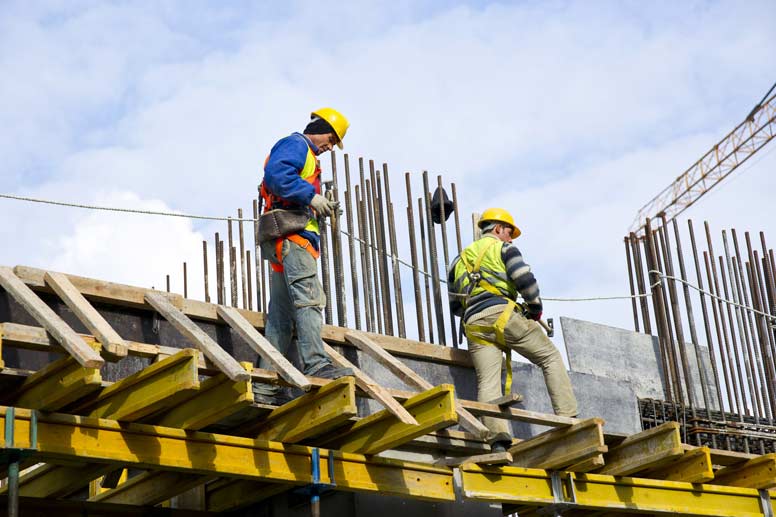How To Estimate Construction Jobs? Step-by-Step Guide

Estimating construction jobs is both an art and a science. It’s about striking the perfect balance between covering your costs, ensuring profitability, and staying competitive in a constantly evolving market.
Whether you’re building a backyard deck or tackling a massive commercial project, accurate estimates are the foundation of your success.
This guide will break down the process into 10 easy steps, helping you navigate construction estimating like a pro.
Along the way, we’ll share practical tips, real-world examples, and tools to make your estimating process smoother and more efficient.
Steps to Estimate Construction Jobs:
What Is Construction Estimating?
Construction estimating is the process of forecasting the costs of a construction project and submitting a bid before it begins.
But it’s not just about crunching numbers. It’s about understanding every detail of the job—from materials and labor to overhead and profit margins.
A well-prepared estimate allows you to bid competitively, plan accurately, and maximize your profitability.
For example, a construction contractor working on a custom home build needs to account for everything from foundation work and framing to finishes and landscaping.
Construction costs must be carefully calculated to ensure the bid is both competitive and profitable.
RELATED ARTICLE: How To Start A Construction Company in 10 Steps?
Foundation Work
Excavation, pouring concrete, and reinforcement can cost anywhere from $15,000 to $50,000, depending on the size and complexity of the foundation.
Framing
The cost of framing materials and labor typically ranges between $20,000 and $50,000, influenced by the home’s square footage and design intricacies.
Finishes
Interior finishes, such as flooring, cabinetry, and painting, can vary widely, averaging $40,000 to $100,000, depending on the quality of materials chosen.
Landscaping
Designing and completing exterior spaces, including lawns, patios, and pathways, may add an additional $5,000 to $30,000to the total cost.

Why Accurate Estimating Matters
Accurate construction estimating is critical for several reasons. It directly impacts profitability, client satisfaction, and project execution. Let’s take a closer look at its benefits:
Winning Bids
Competitive pricing is essential to securing jobs. An accurate estimate ensures you’re not underbidding (which risks losing money) or overbidding (which could cost you the job).
Maintaining Profitability
Underestimating costs can quickly turn a profitable project into a financial disaster. Conversely, overestimating can scare off potential clients. Striking the right balance ensures you stay in the black.
Effective Project Planning
A detailed estimate provides the framework for resource allocation, scheduling, and budgeting. It reduces the risk of surprises, like running out of materials mid-project or exceeding labor budgets.
Building Trust
Clear, accurate estimates show clients that you understand the project and have their best interests in mind. When the final costs align with your projections, it builds credibility and fosters long-term relationships.
RELATED ARTICLE: How Much Do Construction Workers Make? 2025 U.S. Salary Guide

10 Steps to Estimating Construction Jobs
Here’s how to create precise and professional construction job estimates in 10 easy steps:
1. Inspect the Current Site
Every estimate begins with a site visit. Assess the existing conditions, identify challenges, and take detailed notes. Site visits allow you to address potential issues upfront, saving time and money down the line.
For example, If a client wants a driveway extension, your site inspection might reveal underground utilities or drainage issues. Addressing these factors early ensures you bid accurately and avoid unexpected costs.
Pro Tip: Use our Receipt Scanner feature to log mileage, expenses, or material samples during site visits. This ensures no costs are overlooked.
2. Address Building Codes and PCA Standards
Familiarize yourself with local building codes and Property Condition Assessment (PCA) standards. Compliance isn’t optional; failing to meet requirements can lead to fines or project delays. Researching these early helps identify potential costs and avoids surprises.
For example, for a commercial build, ADA compliance (e.g., wheelchair ramps, accessible restrooms) might require additional materials and labor. Including these costs upfront avoids future disputes.
3. Put Together an Assessment
After wrapping up your site visit, it’s time to put together a detailed project assessment. Think of this as your game plan—it outlines the project’s scope, identifies any challenges, and maps out a preliminary timeline. This step is essential because it sets the stage for accurate estimating.
What to include
- Scope of Work: Clearly define what the project includes—what are you delivering, and what’s out of scope?
- Potential Challenges: Highlight any obstacles you might face, like tricky site access, bad weather, or material backorders.
- Preliminary Timeline: Break down key milestones. This will help you estimate labor hours, rental equipment needs, and overall project duration.
For example, if you’re quoting a residential deck, your assessment might look something like this:
- Scope: Design and build a 300-square-foot wooden deck with railings and stairs.
- Challenges: Soil stability could be an issue, and you’ll need to account for time to secure building permits.
- Timeline: Prep and permits (2 weeks), foundation work (3 days), and deck construction (1 week).
By organizing all these details upfront, you’re creating a roadmap that not only simplifies your estimate but also impresses your client with your professionalism.
4. Estimate Construction Material Costs
Materials often account for the largest portion of a project’s budget. Create a detailed list of required materials and their associated costs. Don’t forget to account for potential price fluctuations due to supply chain issues.
For example, for a roofing project, you’ll need to include the cost of shingles, underlayment, nails, flashing, and disposal fees for old materials. You’ll also need to factor in delivery costs and extras like protective tarps.
Use our Estimate Generator to streamline material cost calculations and create professional estimates.
Impress your clients and win more jobs
Use our free cleaning estimate template to create professional-looking estimates.
5. Estimate Labor and Rental Costs
Labor costs can vary significantly depending on the project’s complexity, location, and timeline. Calculate wages based on the required skills and the time needed to complete the project. For equipment rentals, include fees, transportation costs, and operator wages.
For example, if you’re pouring a foundation, you might need to rent an excavator for a week. Factor in rental costs, delivery fees, and the operator’s hourly rate.
Use Invoice Fly’s Time Tracking Software to monitor employee hours and avoid underestimating labor costs.
6. Factor in Overhead and Profit Margin
Overhead costs include everything from office expenses and insurance to marketing and software subscriptions. Once you’ve accounted for these costs, add a profit margin. Most contractors aim for a margin between 10–20%.
On a $100,000 project, a 15% profit margin adds $15,000. This ensures your business stays profitable while covering unexpected expenses.
Periodically review your overhead costs to ensure you’re not overlooking expenses that could eat into your profits.
7. Write the Estimate
Combine all the information into a clear, professional estimate. Your preliminary estimate should include:
- A detailed breakdown of costs (materials, labor, equipment, overhead)
- The project management timeline
- Payment terms and conditions
- A proposed payment schedule
Use Invoice Fly’s Estimating Software feature to create polished estimates that clients can review and approve.
8. Use Estimate Templates for Construction Businesses
Starting from scratch can be time-consuming. Templates save tons of time and ensure consistency. InvoiceFly’s customizable templates can be tailored for various construction jobs, from small remodels to large commercial builds.
For example, if you’re estimating a kitchen remodel, a template might include pre-set categories like cabinetry, countertops, appliances, and plumbing. Adjust these to fit the client’s specific needs.
9. Deliver the Estimate
Timeliness is critical. Deliver your estimate quickly to show professionalism and keep clients engaged. Tools like InvoiceFly’s Client Portal let you send estimates directly to clients and allow them to review and approve online.
For instance, if two contractors bid on the same job, the contractor who delivers a clear, timely estimate is far more likely to secure the job.
10. Follow Up
Don’t just send the estimate. Follow up! Reach out to answer questions, clarify details, or make adjustments based on client feedback. This step demonstrates your commitment and can set you apart from competitors.
RELATED ARTICLE: How To Get A General Contractor License in 2025?

What to Do After Estimating a Job
Once your estimate is in the client’s hands, it’s time to take the next steps:
- Negotiate Terms: Be flexible and open to adjustments based on client feedback.
- Draft a Contract: Once the estimate is approved, create a detailed contract outlining all terms and conditions.
- Plan the Project: Use your estimate as a roadmap for scheduling, budgeting, and resource allocation.
Factors That Influence Construction Estimates
Several variables can impact your estimate. Staying aware of these factors ensures greater accuracy:
- Project Size: Larger projects may benefit from economies of scale, reducing costs per square foot.
- Material Prices: Fluctuations due to supply chain issues or market demand can significantly affect costs.
- Labor Availability: In tight labor markets, competition for skilled workers can drive up wages.
- Timeline: Rushed projects often require overtime pay or expedited shipping, increasing costs.
Stay informed about market trends and maintain relationships with suppliers to anticipate cost fluctuations.
RELATED ARTICLE: How To Get Your Construction Insurance In The U.S. In 2025?
Streamline Estimating with Construction Management Software
Technology can significantly simplify the estimating process. Our Construction Management Software offer features such as:
- Estimate Generator: Quickly create detailed, professional estimates.
- Invoice Maker: Turn your estimates into invoices.
- Invoice Templates: Use our invoice templates to look more professional.
- Online Payments: Get paid faster than ever by Stripe, PayPal and other payment methods.
- Client Portals: Seamlessly share estimates and invoices with clients.
- Organization Tools: Use Receipt Scanners and Time Tracking Software to stay organized.
By automating these processes, you’ll save time, reduce errors, and leave a lasting impression on clients.
Final Thoughts
A solid estimate not only helps you land the job but also builds trust with your clients and keeps everything running smoothly. It’s how you set clear expectations, avoid expensive surprises, and make sure your work is profitable.
By following these 10 steps you’ll create estimates that are both precise and professional.
But remember, estimating isn’t just about securing bids. It’s about showing clients you’re reliable, detail-oriented, and committed to delivering quality work every time.
Ready to transform your estimating process?
Try Invoice Fly today!

Jennifer is a skilled senior copywriter with over 10 years of experience in content strategy, creative, and UX writing and other digital marketing disciplines.
Her work prioritizes clarity and conversion optimization (CRO). The approach is deeply rooted in branding, where she crafts compelling narratives and drives unique and meaningful engagement.
Born in Minnesota, North America, she has deep industry knowledge and experience creating content about banking, accounting, travel, food, SaaS products and mobile apps, as she has work for companies such as Ogilvy, Design, Juni and Qustodio, among many others.



